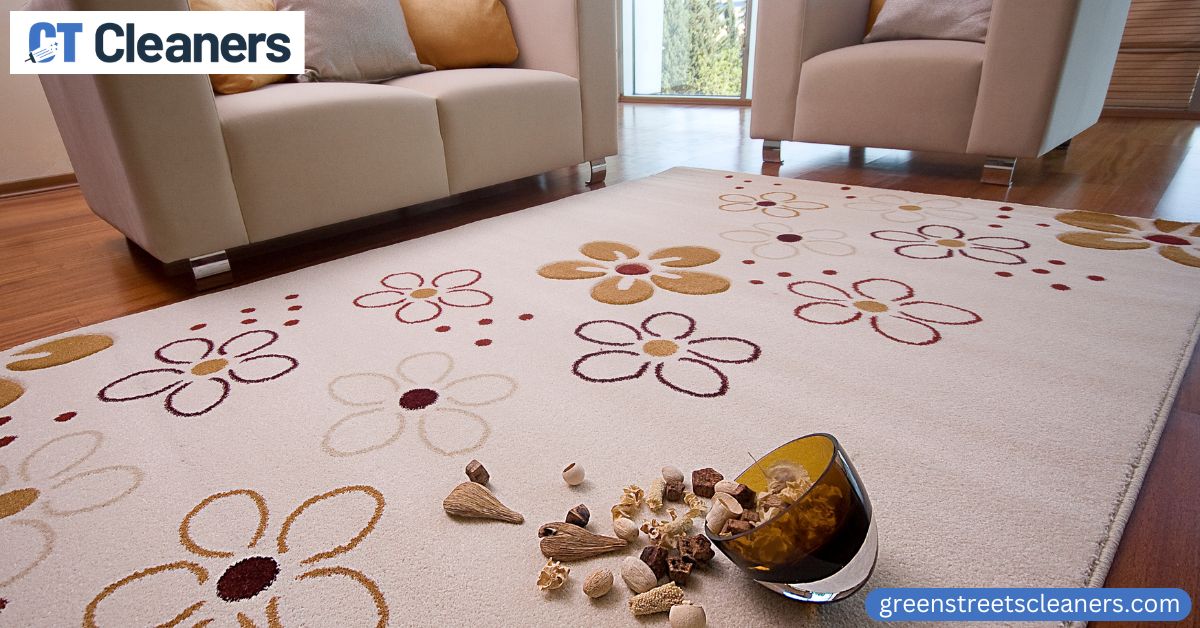Having white mold on your carpet can be a cause for alarm. Not only is it unsightly and potentially hazardous to your health, but it can also lead to damage to the underlying material in your carpets and even spread throughout other areas of the home.

Understanding White Mold on Carpet
White mold on carpet can be an eyesore and a health hazard, making it important to identify and remediate mold issues quickly. But before you can treat mold, it helps to understand its underlying science.
Most mold requires moisture to survive and reproduce. Moisture is the main factor that distinguishes mold from regular dirt or dust. So if you notice patches of white mold sprouting up in your carpeting.
It’s likely caused by excess moisture in the area caused by things like flooding, leaks in plumbing pipes, or windows left open during rainstorms. Floors close to water sources are particularly at risk for mold growth. However, no matter the source behind the mold’s arrival, understanding where it came from is the first step to removal.
Causes of White Mold Growth on Carpet
White mold growth on carpets can occur for several reasons. High humidity in a home is often the main culprit, as moist air is needed for mold to form and thrive. Alternatively, if there has been a leak or water damage to the carpeting, then mold may have grown as a result of that.
Another factor to consider is that carpets are often created with organic materials (like wool). Which provides food sources for the development of white mold, making it difficult to get rid of once it has formed.
In order to prevent white mold from forming, homeowners should ensure their home is kept at the proper humidity level (below 50%), and respond quickly and thoroughly if any dampness or flooding does take place in an area where their carpets are located.
| Causes of White Mold Growth on Carpet | Description |
| High humidity or moisture levels | Mold thrives in moist environments and can quickly grow on carpeting if the humidity levels are high. |
| Poor ventilation in the room | A lack of proper ventilation can lead to increased humidity levels, creating ideal conditions for mold growth. |
| Water damage or leaks in the carpet | Water damage or leaks can lead to saturation of the carpet, which can be a perfect breeding ground for mold. |
| Flooding or heavy water exposure | Heavy water exposure, such as flooding, can increase the moisture levels in the carpet, providing a suitable environment for mold to grow. |
| Lack of regular cleaning and maintenance |
Neglecting to clean and maintain the carpet can allow dirt, debris, and other organic materials to accumulate, creating an ideal food source for mold.
|
| Presence of organic materials | Organic materials, such as food or pet waste, can provide mold with a food source and contribute to its growth. |
| Poor air quality | Poor air quality in a room can allow mold spores to circulate and settle on the carpet, where they can grow. |
| Poorly sealed windows or doors | Poorly sealed windows and doors can allow damp air to enter the room, providing an ideal environment for mold to grow. |
Signs of White Mold Infestation on the Carpet
White mold can be a difficult issue to judge since it often presents in small concentrations that require close inspection to detect. If there is an area of the carpet that is damp for more than 48 hours, there is a possibility of white mold growth.
Households with high humidity levels, poor ventilation, and low light are particularly susceptible to the development of white mold on the carpet. Some common signs of a white mold infestation are discoloration or black spots on the surface, an unpleasant musty odor, general deterioration of fibers over time, and areas where the carpet pulls away from the baseboard due to water damage.
- Visible growth of white or light-colored fuzzy or powdery substance on the carpet
- Musty or damp odor in the room
- Presence of water stains or discoloration on the carpet
- Peeling or bubbling of the carpet
- Health symptoms, such as sneezing, coughing, or headaches, are more noticeable when in a room with the moldy carpet
- Warping or buckling of the carpet
- The presence of mold on nearby surfaces, such as walls or furniture, indicates that mold has spread beyond the carpet.
Prevention of White Mold on Carpet
Carpets are an attractive feature in any home, but they can be vulnerable to damage from mold and mildew. Taking the right steps to prevent white mold on carpets can keep them looking great for years to come.
The first step to prevention is controlling moisture levels in the room with a dehumidifier or humidifier if needed. Additionally, ensuring furniture pieces are not blocking vents can help reduce unnecessary moisture.
Cleaning and removing spots and spills quickly with a carpet stain remover is also essential for keeping white mold from taking hold and damaging the carpet’s fibers. Regular vacuuming of the carpet will help remove dirt and dust build-up.
That could attract unwanted pests that can create desirable conditions for mold growth. Carpet maintenance may take a bit of effort, but it is well worth it for protecting this important investment in your home.
“I had white mold on my carpet that was causing a lot of health problems for me and my family. They were able to get rid of the problem quickly and efficiently and saved us a lot of trouble in the process. Thanks!”
– Carl O., Byram
How to Clean White Mold from Carpet
Carpet cleaning can be a tricky process, especially when attempting to remove white mold from the carpet. To start, vacuum the affected area thoroughly – this will help get rid of some of the loose spores.
Next, mix a solution of one part dish soap and ten parts hot water. With a clean cloth, dab at the stained area. Continue until the mold is gone.
Once finished, rinse with clean water and blot dry with paper towels or a washcloth. To ensure that all soap is removed from the material. Finally, continue regularly vacuuming to prevent future infestations of white mold in your carpets!
In conclusion, white mold on carpets can be a worrisome issue. Not only is it an eyesore, but it can also lead to health hazards and long-term damage if not treated properly. Understanding the causes of white mold growth on carpeting.
And recognizing its signs is essential for preventing future infestations in your home. With proper maintenance such as controlling humidity levels, cleaning spills quickly with a stain remover, and vacuuming regularly.
And using CT Cleaner when needed, you will be able to keep your carpets looking great for years to come. Investing time into keeping your carpets free from white mold now. Can save you money in the long run by avoiding costly repairs or replacements due to water damage.
Don’t wait until it’s too late – take action today so that you don’t have to worry about dealing with any unpleasant surprises down the road!









